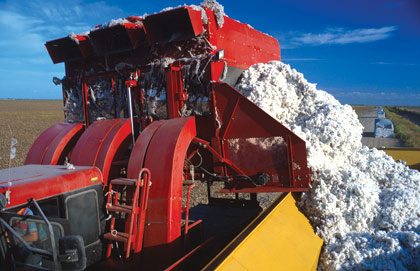Technology Takeoff
More farmers are turning to biotech crops for production and sustainability benefits.
Whether they’re still working the soil with four-legged horsepower or have upgraded to the four-wheeled variety, farmers of all kinds and in all corners of the world increasingly recognize the value in planting genetically engineered crops. From America’s Corn Belt to India’s cotton fields and canola grown on the Canadian Prairies, more genetically-enhanced seed is being planted with the arrival of each growing season. That fact was confirmed earlier this year with the release of the International Service for the Acquisition of Agri-Biotech Applications’ annual report, Global Status of Commercialized Biotech/GM Crops: 2012. Authored by ISAAA founder Clive James, who is also chairman of the organization, the document, also referred to as Brief 44, heralded several important milestones achieved since biotech seed came on the market almost two decades ago, most notably a hundredfold increase in hectares grown—from 1.7 million in 1996 to 170 million in 2012.
 |
|
“[This bean seed] is demonstrating [Brazil’s] impressive technical capacity to develop, deliver and deploy a new state-of-the-art biotech crop.” — Clive James |
The Driving Force
When it comes to the who and why behind biotech acceptance, industry leaders are unequivocal in their response. They believe growers, who’ve seen significant results and benefits thanks to technology, have pushed the estimated $15-billion market to what it is today.
“Since commercialization of the first biotech crop almost 20 years ago, farmers have driven acceptance. Up to this point, most of the biotech traits have directly benefited the farmer with traits like insect and herbicide resistance,” says Cathleen Enright, executive vice president for food and agriculture at the Biotechnology Industry Organization.
And just who are these farmers? Of the 17.3 million men and women who used transgenic seed in 2012, ISAAA estimates that close to 90 percent can be described as small, resource-poor growers who only cultivate between one-half to two hectares of land. Often, the technology that comes in a bag of seed is the farmer’s only access to 21st century advancements in agriculture. “They hire minimal labor as most of the household members help out in the field operations from planting to harvesting. They may still be using animals for tilling the soil or have rented farm implements,” says Rhodora Aldemita, a senior program officer with ISAAA’s Southeast Asia Center in the Philippines.
This trend was also mirrored in the report’s analysis of biotech use by country. For the first time, developing countries grew more of the world’s genetically engineered seed than industrial nations, a 52 to 48 percent split. Twenty of the 28 countries planting biotech seed in 2012 are considered developing. “I believe the industry has always anticipated the benefits biotechnology would have for developing countries and smallholder farmers since agriculture is such a big part of their economies and livelihoods, respectively,” Enright says.
Although the gains are mainly farmer-centric, Jerome Konecsni, chairman of the Agricultural Biotechnology International Conference, says profitability among all the industry players can’t be overlooked when it comes to adoption. “If everyone in the value chain doesn’t make more money from developing and growing a GM product, they will not buy or invest in it,” he says.
For example, in 1995 in Canada the first herbicide tolerant canola entered the market. Since then, yields and canola acres have increased dramatically and, in an effort to keep pace with the higher output, the processing and transportation industries have also seen sizeable growth. In 2011, more than half of the country’s canola acres were grown in the province of Saskatchewan, and according to the Saskatchewan Canola Development Commission, the province is home to seven canola processing plants, including the largest soft seed facility in North America. In all, with a national 97.5 percent adoption rate, the transgenic crop contributed $5.4 billion to the province’s economy in 2011.
With those impressive figures, it made a great deal of financial sense, Konecsni says, that the province declared it would invest $10 million in biotech research at the 2010 Agricultural Biotechnology International Conference.
The ISAAA report estimates that worldwide transgenic crops have increased production by about $98 billion since 1996. Then there are the economic benefits that come from what’s been saved—473 million fewer kilograms of pesticides, a reduction of 23.1 billion kilograms in carbon dioxide emissions and the conservation of 108 million hectares of land.
Transgenic cotton is found in 14 of the 28 countries where biotech crops are grown.

“Though Brazil currently ranks second in biotech acreage, the increase in acres planted in 2012, 21 percent, was greater than any other country, including the United States.” — Cathleen Enright |
South American Surge
If there is one country that can serve as the poster child for biotech adoption, it would have to be Brazil. James, in Brief 44, refers to the South American nation as “the engine of growth globally.” Currently the country constitutes 21 percent of all hectares growing genetically engineered crops.
“Brazil reformed its regulatory policies in 2005 and by 2011 it was outpacing the United States in approval and production rates. Though Brazil currently ranks second in biotech acreage, the increase in acres planted in 2012, 21 percent, was greater than any other country, including the United States,” Enright adds.
James also gives credit to the country’s “fast-track approval system” for allowing Brazil to see such impressive gains. The nation is poised, he adds, to see an even greater surge with a home-grown biotech bean seed, the EMBRAPA 5.1. Resistant to the bean golden mosaic virus, this seed is the first ever transgenic crop to be created in a developing country entirely by a public institution, the Empresa Brasileira de Pesquisa Agropecularia or Brazilian Agricultural and Livestock Research Company.
This bean seed, James says, “is demonstrating [Brazil’s] impressive technical capacity to develop, deliver and deploy a new state-of-the-art biotech crop.”
Maintaining Momentum
So what can be done to foster continued adoption of genetically modified seed? There are several practical places to start, the experts say. Addressing shortage supplies through the establishment of regional seed production centers and advocating for the creation of reasonable regulatory systems are just a few of the factors identified by the ISAAA.
Fostering public-private partnerships is also key. Industry experts point to successful ventures such as the work done with canola in Canada that saw Agriculture and Agri-Food Canada, the National Research Council Plant Biotechnology Institute and Hoechst team up to create the first registered herbicide tolerant seed.
“At the Wheat Summit held in 2012, industry representatives clearly stated the need for the public and private sectors to work together. For example, the industry would like access to public sector germplasm to develop its own varieties. It is also important for public sector researchers to focus on areas where it is not easy for the private sector to get a return [on investment], such as pests and diseases. This research can then be used by private sector breeders in their variety development,” Konecsni says.

“It is also important for public sector researchers to focus on areas where it is not easy for the private sector to get a return [on investment], such as pests and disease.” — Jerome Konecsni |
It’s also important that countries reach out to one another with assistance when possible. Aldemita points to the progress the Philippines has realized in Southeast Asia. That country was the first to establish a regulatory system of its own and has since helped others in the region do the same. “Examples of like-minded countries working together to solve global challenges are many, from security and humanitarian to environmental and economic adversities. Biotechnology is connected to solving each,” Enright observes.
Still, any success in the research lab or with government regulators won’t count for much unless the biotech message is spread accurately and effectively.
Konecsni says the seed industry must consider the social context that the agriculture supply chain functions in. Consumer reaction to genetically engineered crops continues to be based on emotions rather than facts and, by nature, public attention gravitates toward emotionally-laden topics, he says. “One of the important messages that needs to get out is that genetically modified technology is only one tool in the biotechnology tool kit. There are many other advanced technologies that scientists, producers and seed companies can and have used that will improve productivity and produce better quality foods in a more environmentally sustainable manner,” Konecsni says, mentioning the use of genomics in developing plant breeding markers, mutagenesis and gene editing.
Aldemita says it’s hard to think that ignorance or misconceptions about genetically engineered crops force some of the world’s neediest populations to remain in poverty. “It is troubling to know that there are still countries and people who do not or do not want to understand the science of biotech crops, its safety and the benefits even if they are on the brink of hunger and famine. Efforts must be doubled among those who understand the technology to share the knowledge, understanding and practice to the less-privileged,” she says.
This can best be accomplished by spreading the message with one voice, Konecsni says. “The entire agriculture community needs to work together in a collaborative, rational manner—putting aside personal biases and agendas—if we are going to meet the demands for food in the next 50 years and improve the quality of food we are producing,” he says.













